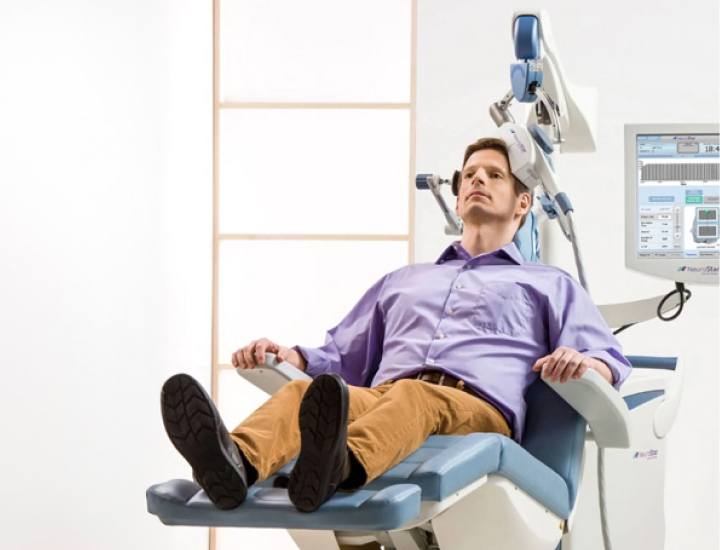
Major Depressive Disorder (MDD), commonly known as clinical depression, is a mental health condition characterized by persistent and pervasive feelings of sadness, hopelessness, and a lack of interest or pleasure in activities. It is more than just experiencing occasional bouts of low mood; MDD involves a persistent low mood and a range of other symptoms that significantly impact a person’s daily life.
Key features of Major Depressive Disorder may include:
Depressed Mood, Loss of Interest or Pleasure, Changes in Appetite or Weight, Sleep Disturbances, Psychomotor Agitation or Retardation, Fatigue or Loss of Energy, Feelings of Worthlessness or Guilt, Difficulty Concentrating, Recurrent Thoughts of Death or Suicidal Ideation.
NeuroStar is a non-invasive, outpatient treatment that takes 20 minutes per day. During each session, a cushioned coil is precisely placed against your head while magnetic pulses deliver the therapy to the correct location that regulates mood in your brain.
You may feel a tapping, tingling, or warming sensation where the coil is positioned. This is usually temporary and subsides with subsequent treatments. You will be awake and alert during the treatment and may resume regular activities immediately afterward.
NeuroStar is a safe, proven alternative for treating major depression.

Your brain is made of billions of neurons which work by sending electrochemical signals to one another. Sometimes, the section of the brain responsible for mood control may be underactive which can result in depression symptoms. Transcranial Magnetic Stimulation (TMS) therapy uses coils that generate small electromagnetic pulses to target those specific areas to stimulate the neurons and make them more active. The stimulation is required to be carried out regularly for some time so the neurons stay active for a longer time. A simple analogy is like going to the gym every day, trying to gain muscle and keep the gains even if you stop going to the gym, but instead of using physical weights, we use electromagnetic pulses, and the muscle is your brain.
The main difference is the type of coil used to produce the electromagnetic pulses. rTMS creates a narrow electromagnetic beam that can be focused on the left dorsolateral prefrontal cortex. “Deep TMS” or dTMS creates wider beams that can penetrate the brain more deeply. At this point, there has been more research proving the positive effects of rTMS, which is why we also use rTMS equipment from NeuroStar.
The first session includes a mapping of a portion of your brain and can take up to 40 minutes. Afterward, you will have 35 daily sessions, each lasting less than 20 minutes. The entire treatment cycle will take no longer than 2 months.
During the initial sessions, you may have a mild headache, lightheadedness, tingling, or mild facial twitches that resolve shortly after the treatment. However, over multiple sessions, these side effects mostly disappear.
rTMS is FDA-approved and requires no surgery, medication, or anesthesia. The electromagnetic pulses are very weak and do not cause any memory loss or seizures in almost all cases. The side effects are also short-term and minimal. People with a history of seizures will need additional attention before any rTMS is started.
Even though your mood can improve after the first few sessions, it is necessary to complete your treatment cycle for a more lasting, or even permanent reduction in your depression symptoms. Furthermore, in case the depression symptoms reappear and another cycle of treatment is requested, it will be difficult to get insurance coverage unless the previous treatment cycle was completed.
You can feel improvement in your mood and a reduction in your depression symptoms after the first few treatment sessions. However, it is important to continue the treatment cycle for the effects to be longer-lasting.
At Tompkins TMS, we try our best to diminish your depression symptoms and improve your mood, but you should never change your anti-depressant dosage without consulting your prescribing doctor or nurse practitioner first. Communication with your other clinicians is important to us.
TMS therapy can be an expensive treatment but is covered by most insurance providers for eligible patients. That is why we first do free consultations and gather information to send to insurance pre-authorization. Before starting treatment, we make sure the insurance policy covers the TMS treatment and the patient only has to pay a small amount of co-pay, if any.
Sometimes, even after a successful TMS treatment cycle, the depression symptoms may start to reappear. Thus, another cycle of TMS therapy may be prescribed and we will perform the insurance pre-authorization again to confirm it can be covered by the policy. This generally occurs 6-24 months after the first treatment.